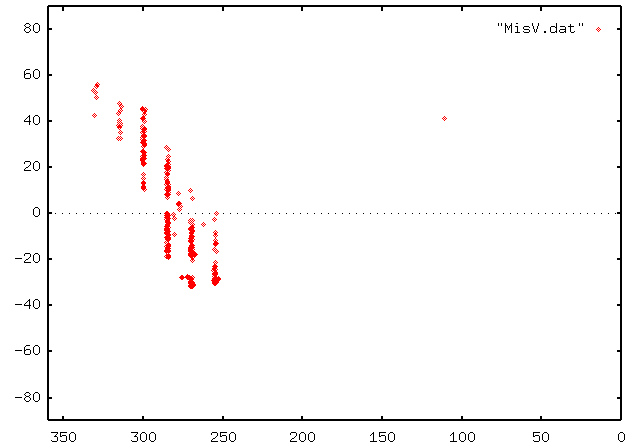Japanese version Home Page Updated on September 26, 1999
September 21, 1999Overlap of variable star surveyMISAO Project Announce Mail (September 21, 1999) Hello. I am Seiichi Yoshida working on the MISAO project. On September 21, 1999, the number of new variable stars discovered in the course of the MISAO Project (MisV objects) reached to 472. Since July 22 when the discovery of the 100th star MisV0100 was announced, the number is increasing about 6 stars a day. All of the new variable stars were discovered on the CCD images taken by KenIchi Kadota, Ageo Survey Team. The Ageo Survey Team has been searching mainly in the summer Milky Way. Therefore, most of the new variable stars are in the summer Milky Way. The chart below shows the new variable stars plotted on the celestial globe. The horizontal axis is right ascension in degree, the vertical axis is declination. 
Not only the MISAO Project, but there are some other variable star survey projects now and many variable stars have been discovered. Now that the survey area of the Ageo Survey Team is getting wider, some variable stars found in the MISAO Project happen to have been already discovered by the other projects. On the images taken by KenIchi Kadota between February and July in 1999, an unknown variable star from 10.8 mag to 12.0 mag was found at R.A. 19h02m25s.63, Decl. -00o30'14".5 (2000.0). No variable star is recorded at this position in the GCVS (General Catalog of Variable Stars) 4th edition and the NSV (New Catalogue of Suspected Variable Stars) catalogs. So we announced this object as a new variable star MisV0130. However, Taichi Kato pointed out that this was already discovered by the FASTT (Flagstaff Astrometric Scanning Transit Telescope) project and published as HS1332 (FASTT1332). This is the first case that a variable star found in the MISAO Project has been already discovered by the other project working on right now. In order to be avoid confusion, we will cancel the number MisV0130 for this object. Therefore, only the MisV0130 is not a new object of the MISAO Project among 472 MisV objects. The FASTT project found 1602 variable stars using the FASTT telescope at the U.S. Naval Observatory in the SDSS calibration fields (including some known variable stars, not new ones). After that, we added the FASTT stars into the MISAO Project database, so we will never announce them as new objects by mistake. Actually, we also detected the variability of HS1330 (FASTT1330), HS1463 (FASTT1463), HS1466 (FASTT1466), but we do not announce them as new variable stars. By the way, there must be known variable stars V886 Aql and VX Aql near by HS1463 (FASTT1463) and HS1466 (FASTT1466) respectively. However, no other variable stars are found around these FASTT objects on the Ageo Survey Team images. Therefore, we judged HS1463 (FASTT1463) and V886 Aql are the same object, HS1466 (FASTT1466) and VX Aql are the same object. To return to the subject, on the images taken by KenIchi Kadota between April and August in 1999, another unknown variable star from 12.9 to 14.7 mag was found at R.A. 17h59m41s.66, Decl. -00o35'31".0 (2000.0). No variable star is recorded at this position in the GCVS and NSV catalogs. However, Taichi Kato pointed out that this was already discovered by the TASS (The Amateur Sky Survey) project and published as TASS J175944.6-003558. Therefore, we did not announce it as a new object, either. The TASS project is a collaboration of amateur astronomers in the world and 50 new variable stars have been discovered. We also added these stars to the MISAO Project database. All of the TASS new variable stars are around the equator, the declination is between -2.4 deg and +1.5 deg. Many of the FASTT new variable stars are also around the equator. But in the MISAO Project, many new variable stars, not discovered by these projects, were discovered even around the equator. Actually, between +/- 2 deg around the equator, we discovered 18 new variable stars such as MisV0009. In the OGLE (Optical Gravitational Lensing Experiment) project, 58 new long-period variable stars were discovered, and 56 of them are in the 7x9 deg area around R.A. 18h, Decl. -30 deg. In fact, it is also the area where the Ageo Survey Team searched most enthusiastically. The number of MisV new variable stars in this area is 86, about 18% of all. However, no variable star discovered in the MISAO Project happened to have been discovered already by the OGLE project. In addition, Japanese amateur astronomers Kesao Takamizawa and Katsumi Haseda have discovered 515 and 32 new variable stars respectively. However, no variable star discovered in the MISAO Project happened to have been discovered already by them. As a conclusion, many variable stars must be remained unknown even in the area where some projects have searched in past. There are many areas not yet searched all over the celestial globe, so enormous variable stars must be remained unknown. The lists of new variable stars discovered by the projects introduced here are available at "Reference Catalogs" in the MISAO Project Home Page: http://www.info.waseda.ac.jp/muraoka/members/seiichi/misao/doc/reference.html
P.S. http://www.info.waseda.ac.jp/muraoka/members/seiichi/misao/ -- Seiichi Yoshida seiichi@muraoka.info.waseda.ac.jp http://www.info.waseda.ac.jp/muraoka/members/seiichi/index.html |
